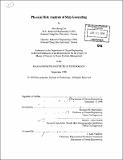Physical risk analysis of ship grounding
Author(s)
Lin, Shu-chiang, 1967-
DownloadFull printable version (5.115Mb)
Advisor
Nicholas M. Patrikalakis and Hauke L. Kite-Powell.
Terms of use
Metadata
Show full item recordAbstract
The first part of this thesis presents an analysis on the factors contributing to groundings when ships transit in and out of ports. The study has been part of a three-year project on "Ship Transit Risk". By verifying the grounding location database generated during the first two years of the project against the United States Coast Guard's grounding accident data, an updated database was established in this research. Within the frame of this new database, two factors were analyzed-tide and time of day. The results suggest that tide forecast error (predicted tide water level minus observed tide water level) had no significant effect as a risk factor, and that night navigation was far more risky than day navigation. The second part of this thesis presents a complementary point of view for risk analysis human factors. Many papers indicate that human beings are the most significant factors contributing to groundings. Nevertheless, few or no historical data sets recorded the information required for human factors analysis. Hence this part focuses mostly on literature review, introduces briefly the concept of the International Safety Management (ISM) Code, and some maritime regulations and final rules of OSHA (Occupational Safety and Health Administration). OSHA contributes to much research in human factors, yet few maritime related papers pay attention to it. Thus, we suggest that for further research on human factors, the collaboration of OSHA and maritime related research organizations such as USCG is necessary. The cooperative research would greatly contribute to the success of a risk model for groundings that may be also applied to other accident analysis. In addition, the exploration of a risk model for groundings may have a positive effect on the ISM code and OSHA's final rules in the future.
Description
Thesis (S.M.)--Massachusetts Institute of Technology, Dept. of Ocean Engineering, 1998. Includes bibliographical references (leaves 80-85).
Date issued
1998Department
Massachusetts Institute of Technology. Department of Ocean EngineeringPublisher
Massachusetts Institute of Technology
Keywords
Ocean Engineering